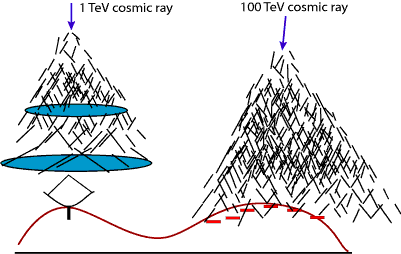|
|
|
|
|
|
People
and institutions that
designed and built Milagro
|
|
|
|
|
The Detection of Cosmic Rays
Cherenkov Radiation
As the extensive air shower traverses the earth's atmosphere the relativistic
charged particles in the pancake emit Cherenkov light. Cherenkov light
is the electromagnetic equivalent of a sonic boom. It occurs when a
charged particle travels through a medium faster than light can travel
through that medium. Remember, although nothing can travel faster than
light in a vacuum, light slows down when it enters a medium. There is
no such limitation on particles. The speed of light in a medium is just
the speed of light in a vacuum divided by the index of refraction of
the medium.
Detecting an Extensive Air Shower
This leads to two different methods that can be used to detect the
passage of an extensive air shower: one can look for the particles in
the pancake directly, or one can look for the Cherenkov light generated
by the particles in the atmosphere. The figure below illustrates both
techniques.

On the left is an air Cherenkov telescope (ACT).
These are large mirrors that focus the Cherenkov light generated by
the air shower onto an array of PMTs, which form an image of the air
shower. Properties of the image are used to distinguish between air
showers generated by gamma-ray primaries and nuclear primaries. Though
very few particles may survive to the ground, the Cherenkov light will
reach the ground. Thus, air Cherenkov telescopes can detect lower energy
cosmic rays than extensive air shower arrays. However, since they are
optical instruments they can only operate on clear moonless nights and
they can only view a small piece of the sky at a time.
On the right is an extensive air shower array (EAS array).
An EAS array has traditionally been composed of a sparse array of
plastic scintillators. The scintillators detect the passage of charged
particles that travel through them. They are very inefficient detectors
of the gamma rays in the EAS. Since gamma rays outnumber electrons and
positrons by a ratio of roughly 4:1 and the scintillator covers less
then 1% of the total area of the array, traditional EAS arrays have
rather high energy thresholds. Unlike ACTs EAS arrays can operate under
all conditions, night or day, and can view the entire overhead sky continuously.
By using buried counters they can detect the muons in air showers generated
by cosmic-ray nuclei. However, this method of distinguishing between
gamma rays and nuclear cosmic rays is not as efficient as the imaging
method used by ACTs. The table below indicates the advantages and disadvantages
of each type of instrument.
| |
Air Cherenkov Telescope
|
Extensive Air Shower Array
|
|
Energy Threshold
|
Low (<200 GeV)
|
High (>50 TeV)
|
|
Background Rejection
|
Excellent (>99.7%)
|
Moderate (>50%)
|
|
Field of View
|
Small (~2o)
|
Large (>45o)
|
|
Duty Cycle (On time)
|
Low (5-10%)
|
High (>90%)
|
Another way
Milagro was designed to combine the low energy threshold of ACTs with
the large field of view and high duty cycle of EAS array. |
|
|

